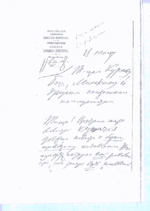Lenin's Hanging Order


The Hanging Order is a name given by the U.S. Library of Congress to Russian Communist Vladimir Lenin's telegram on suppressing the kulak revolt in the Penza Gubernia region.[1] The telegram was addressed to Penza Communists Vasily Kurayev (Penza Soviet chairman), Yevgenia Bosch (the chairwoman of Penza Gubernia Party Committee) and Alexander Minkin (the chairman of Penza ispolkom) and dated 11 August 1918.
Historical background

During the summer of 1918, many of Russia's central cities, including Moscow and Petrograd, were cut off from the grain-producing regions of Ukraine, northern Caucasus, and Siberia by the civil war. As a result, hundreds of thousands of people were on the brink of starvation. The Penza Gubernia was critical in providing food to the cities, but the government used drastic measures, such as prodrazvyorstka (forcible requisitioning), to collect grain from the peasants. The Central Committee sent Yevgenia Bosch to supervise grain collection.[2][3]
A peasant revolt erupted in the Kuchkino Volost of Penza Uyezd on 5 August 1918, in opposition to requisitioning, and soon spread to neighbouring regions. While Penza Soviet chairman Kurayev opposed the use of military force and argued that propaganda efforts would be sufficient, Bosch insisted on using the military and mass executions.[3] By 8 August 1918, Soviet forces had crushed the revolt, but the situation in the gubernia remained tense, and a revolt led by members of Socialist-Revolutionary Party erupted in the town of Chembar on 18 August. Lenin sent several telegrams to Penza demanding harsher measures in fighting these kulak, peasant and Left SR insurrectionists.[4][5]
11 August 1918 cable
In particular, one telegram (dated 11 August 1918) instructed the Communists operating in the Penza area to publicly hang at least one hundred kulaks, to publicize their names, to confiscate their grain, and to designate a number of hostages. Whether anyone was actually hanged according to this order remains unknown. On 19 August 1918, Lenin sent another telegram to Penza expressing exasperation and modifying his previous instructions:[6]
Lenin's so-called "Hanging Order" was discussed during a controversy about the BBC documentary Lenin's Secret Files (1997) based upon Robert Service's findings in Soviet archives. This is Service's English translation of the Russian original:
"Comrades! The insurrection of five kulak districts should be pitilessly suppressed. The interests of the whole revolution require this because 'the last decisive battle' with the kulaks is now under way everywhere. An example must be demonstrated.
- Hang (and make sure that the hanging takes place in full view of the people) no fewer than one hundred known landlords, rich men, bloodsuckers.
- Publish their names.
- Seize all their grain from them.
- Designate hostages in accordance with yesterday's telegram.
Do it in such a fashion that for hundreds of kilometres around the people might see, tremble, know, shout: "they are strangling, and will strangle to death, the bloodsucking kulaks".
Telegraph receipt and implementation.
Yours, Lenin.
Find some truly hard people"[7]
Footnotes
- ↑ Library of Congress Translation
- ↑ Loginov, Vladlen (1999). "Послесловие" [к сборнику "В. И. Ленин. Неизвестные документы. 1891-1922гг."]. Ленин В.И. Неизвестные документы. 1891-1922 гг (in Russian). Rospen. Retrieved 21 April 2010.
- 1 2 Poluboyarov, Mikhail. Preface to Vasily Kurayev diary (in Russian).
- ↑ Lenin Collected Works, Progress Publishers, 1971, Moscow, Volume 36, page 489. "Telegram to Yevgenia Bosch"
- ↑ "An exchange of letters on the BBC documentary Lenin's Secret Files"
- ↑ Telegram to the Penza Gubernia Executive Committee of the Soviets in J. Brooks and G. Chernyavskiy's, p.77, Lenin and the Making of the Soviet State: A Brief History with Documents (2007). Bedford/St Martin’s: Boston and New York: p.77
- ↑ Translation of 'hanging order' by Robert Service, p. 365, Lenin a Biography (2000). London: Macmillan